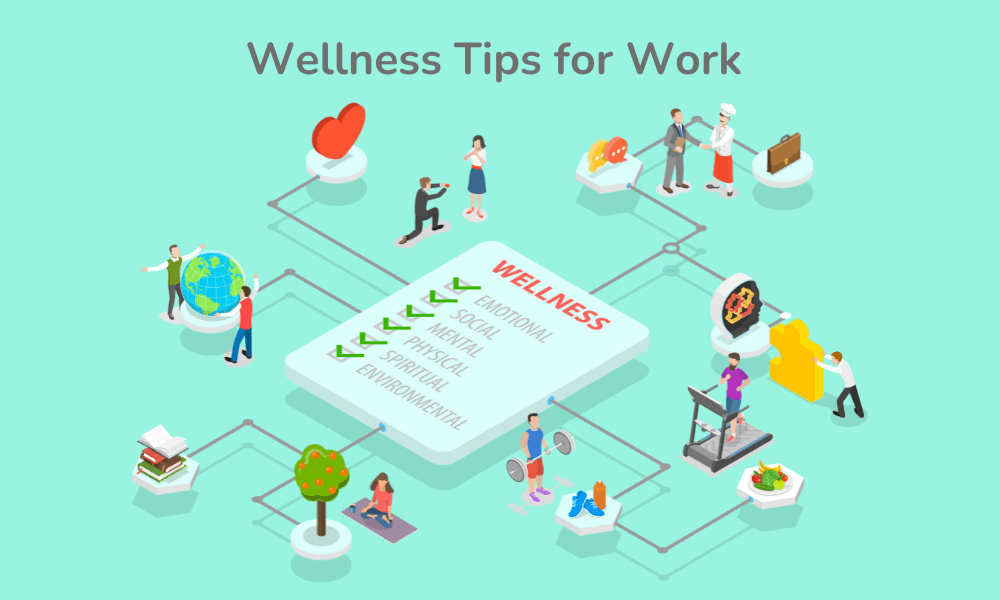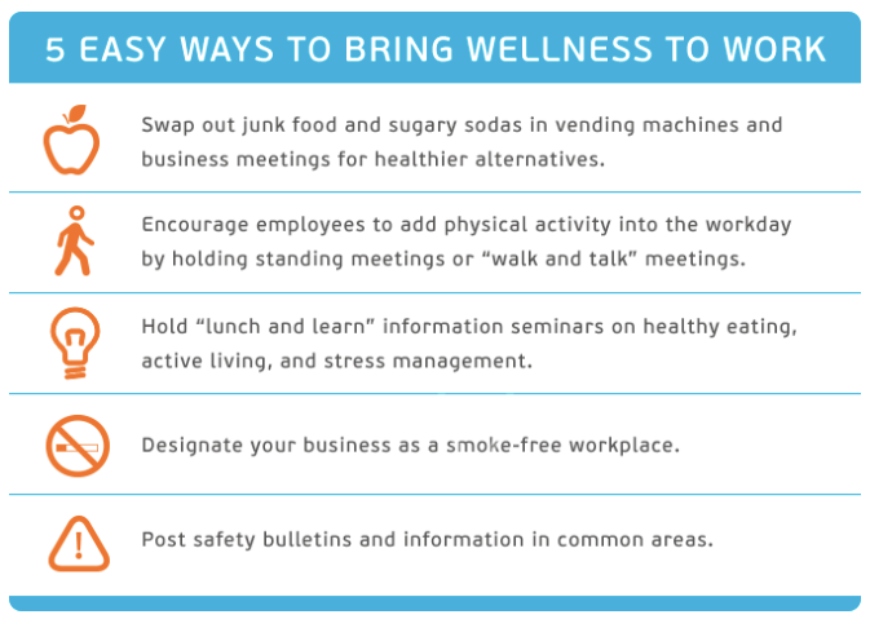Workplace Wellness Tips - 18 Proven Strategies For Productivity
Discover practical workplace wellness tips. Improve employee health and productivity effectively.
Author:James PierceReviewer:Karan EmeryMar 01, 2024413 Shares25.8K Views

In today's fast-paced and demanding work environments, prioritizing employee well-being is essential for both individual and organizational success. workplace wellness tips are aimed at promoting physical, mental, and emotional health among employees. In this article, we will explore actionable workplace wellness tips and initiatives, fostering a culture of health, productivity, and satisfaction.
Have a look at 18 workplace wellness tips:
Encourage Physical Activity
Promote regular physical activity by providing onsite fitness facilities, organizing group exercise classes, or implementing walking meetings. Encourage employees to take short breaks throughout the day to stretch, walk, or engage in brief exercise routines to combat sedentary behavior and improve circulation.
Foster A Healthy Work Environment
Create a workspace that supports ergonomic principles, providing ergonomic furniture, adjustable desks, and proper lighting to reduce the risk of musculoskeletal injuries and promote comfort. Implement policies that encourage good posture, regular breaks, and proper lifting techniques to minimize physical strain and enhance employee well-being.
Prioritize Mental Health
Offer resources and support for mentalhealth, including access to counseling services, employee assistance programs (EAPs), and mindfulness training. Promote work-life balance by encouraging flexible work arrangements, telecommuting options, and setting realistic workload expectations to reduce stress and prevent burnout.
Promote Healthy Eating Habits
Provide healthy food options in the workplace, such as fresh fruits, vegetables, whole grains, and lean proteins, through cafeteria menus, snack bars, or vending machines. Educate employees about nutrition and healthy eating habits through workshops, seminars, or cooking demonstrations to empower them to make informed dietary choices.
Clean Up Your Workspace
Clean your desk, keyboard, mouse, and any other surfaces you come into contact with before starting and concluding your shift. When cleaning, make sure to use EPA-approved materialsand thoroughly sanitize the area. Make sure to wipe off a surface completely, including any crevices and corners, in order to adequately disinfect it.
Take Full Breaks
Utilize your break time to its fullest potential in order to unwind and recharge. If you work indoors, make time in your schedule to step away from your desk and enjoy some sunshine and fresh air. Take at least one 30-minute break per shift and, if possible, a 10 to 15-minute break per hour.
Frequently Wash Your Hands
Hand washing with soap and water for at least 20 seconds is one of the greatest ways to avoid disease. Place signs advising people to wash their hands in toilets and other public spaces, if at all possible. It is especially crucial to wash after handling objects, surfaces, or other people. Use hand sanitizer if you are unable to wash your hands frequently, especially if you come into contact with shared surfaces. Make sure the hand sanitizer you use has at least 60% alcohol by volume.
Try To Meditate
One excellent method to detach and concentrate on your mental health is through meditation. Studies indicate that it can assist in lowering blood pressure, easing anxiety, and reducing stress. Additionally, putting the day behind you and focusing on some alone time can be achieved by concluding the day with a stress-relieving meditation.
Consider implementing a meditation program in your company to provide guided team meditation. Team members can leave meetings feeling revitalized and renewed by introducing these kinds of programs with ease.
Foster A Culture Of Support And Inclusion
Cultivate a supportive and inclusive work environment where employees feel valued, respected, and heard. Encourage open communication, collaboration, and teamwork, fostering positive relationships among colleagues and reducing feelings of isolation and loneliness.
Offer Wellness Programs And Incentives
Implement workplace wellness programs that incentivize healthy behaviors, such as participation in fitness challenges, smoking cessation programs, or weight loss initiatives. Provide incentives such as gift cards, fitness trackers, or extra time off for achieving wellness goals and milestones, motivating employees to prioritize their health.
Promote Stress Management Techniques
Teach stress management techniques such as deep breathing exercises, meditation, or yoga to help employees cope with stress and anxiety effectively. Encourage the use of relaxation spaces or quiet rooms where employees can take short breaks to recharge and decompress during hectic workdays.
Stay Social
Not being able to see your coworkers every day is one of the hardest parts about working from home or in a mixed setting. You see your coworkers more often than your families, after all. Whether it's through virtual Happy Hours for teams or Zoom lunches, make it a point to stay in touch and strengthen your bonds with your colleagues.
Try Some Music Too
For many, listening to music is a wonderful way to improve mood and boost morale. Make a playlist of music that will inspire you to work hard during the day. To remain in touch, you can even try sending your friends and coworkers playlists. For some motivation, listen to our "Motivation for Working" playlist!
Support Financial Wellness
Offer financial wellness resources and education to help employees manage their finances, plan for the future, and alleviate financial stress. Provide access to financial planning workshops, retirement savings programs, and resources for debt management and budgeting.
Lead By Example
Demonstrate a commitment to workplace wellness by fostering a healthy lifestyle and work-life balance as leaders and managers. Encourage leaders to participate in wellness initiatives, set a positive example, and prioritize their own well-being to inspire employees to do the same.
Solicit Feedback And Adapt
Regularly solicit feedback from employees to assess the effectiveness of workplace wellness initiatives and identify areas for improvement. Adapt wellness programs and initiatives based on employee feedback, evolving needs, and emerging trends to ensure they remain relevant and impactful.
Make The Most Of Your Vacation Days
For whatever reason, workers frequently feel bad about using up all of their vacation time, even though it's a benefit to which we are entitled to the same as our pay. But having time off and vacation is crucial for your emotional and physical well-being. Taking time off boosts wellbeing, lowers burnout, and boosts productivity. Use every day you have off or vacation to make this year's resolution come true.
Appreciate Your Employees
Companies now more than ever need to maintain a positive work environment because of the new challenges that are emerging in the workplace. For employees to succeed and be productive, it is critical to provide wellness programs and services.
Another excellent method to lift your emotions is to provide positive reinforcement through milestone presents or client testimonials. Try distributing an employee recognition survey to inform your company's reward and recognition program and have a better idea of how your staff members would like to be honored.
Workplace Wellness Tips - FAQs
How Can Employers Encourage Physical Activity In The Workplace?
Employers can encourage physical activity by providing onsite fitness facilities, organizing group exercise classes, and promoting active breaks throughout the workday.
What Role Does Mental Health Play In Workplace Wellness?
Mental health is integral to workplace wellness, and employers can support it by offering resources such as counseling services, mindfulness training, and promoting work-life balance.
How Can Employers Promote Healthy Eating Habits Among Employees?
Employers can promote healthy eating habits by providing nutritious food options in the workplace, offering nutrition education, and encouraging mindful eating practices.
How Can We Improve Mental Health In The Workplace?
Employees should be honored for their contributions to the business. Invest in each employee's professional training and career development initiatives. Provide perks like work-from-home options and flexible scheduling that support work-life balance.
How Do You Deal With Bad Mental Health At Work?
Setting priorities for their work might be challenging for individuals who experience pressure. Increased one-on-one supervision and flexible work schedules can aid in improving time management, planning, and prioritization skills. For some, having a routine troubleshooting session with their management akin to a surgery is beneficial.
How Do You Ensure Employee Wellness In A Company?
- Give workers the tools they need to recognize and resolve issues at work.
- Take action to help staff members feel like they belong in the social sphere.
- Give managers the resources they require to assist staff members with their personal struggles.
- Make sure that workloads are fair and appropriate.
How Can You Promote Personal Wellness?
- Adhere to a nutritious diet.
- Cut back on your snacking.
- Sip a lot of water.
- Increase your movement.
- Walk more and take more steps throughout the day.
- Make sure you get enough rest.
- Restrict your alcohol intake. Due to its high calorie content, alcohol may exacerbate health issues that are typical in older persons.
- Steer clear of tobacco products.
Why Is Financial Wellness Important In The Workplace?
Financial wellness is important in the workplace because it helps employees manage their finances, reduce stress, and improve overall well-being.
What Are The Benefits Of Investing In Workplace Wellness?
Investing in workplace wellness benefits both employees and employers by improving health and happiness, reducing absenteeism, increasing productivity, and enhancing overall company culture.
Conclusion
Investing in workplace wellness is not only beneficial for employees' health and happiness but also for organizational success and productivity. By implementing these workplace wellness tips and fostering a culture of well-being, employers can create a supportive and thriving work environment where employees can thrive personally and professionally.
Jump to
Encourage Physical Activity
Foster A Healthy Work Environment
Prioritize Mental Health
Promote Healthy Eating Habits
Clean Up Your Workspace
Take Full Breaks
Frequently Wash Your Hands
Try To Meditate
Foster A Culture Of Support And Inclusion
Offer Wellness Programs And Incentives
Promote Stress Management Techniques
Stay Social
Try Some Music Too
Support Financial Wellness
Lead By Example
Solicit Feedback And Adapt
Make The Most Of Your Vacation Days
Appreciate Your Employees
Workplace Wellness Tips - FAQs
Conclusion

James Pierce
Author

Karan Emery
Reviewer
Latest Articles
Popular Articles

